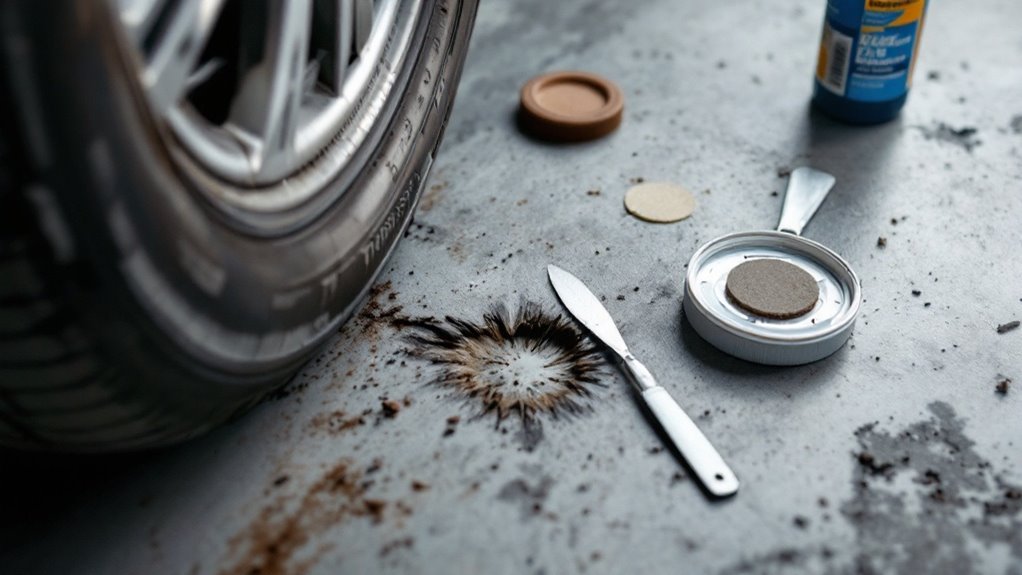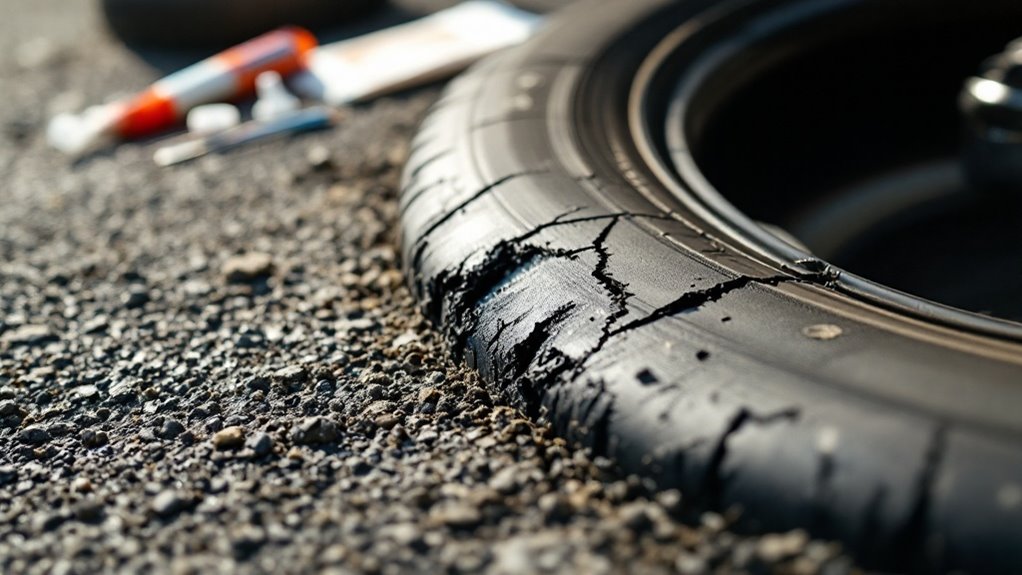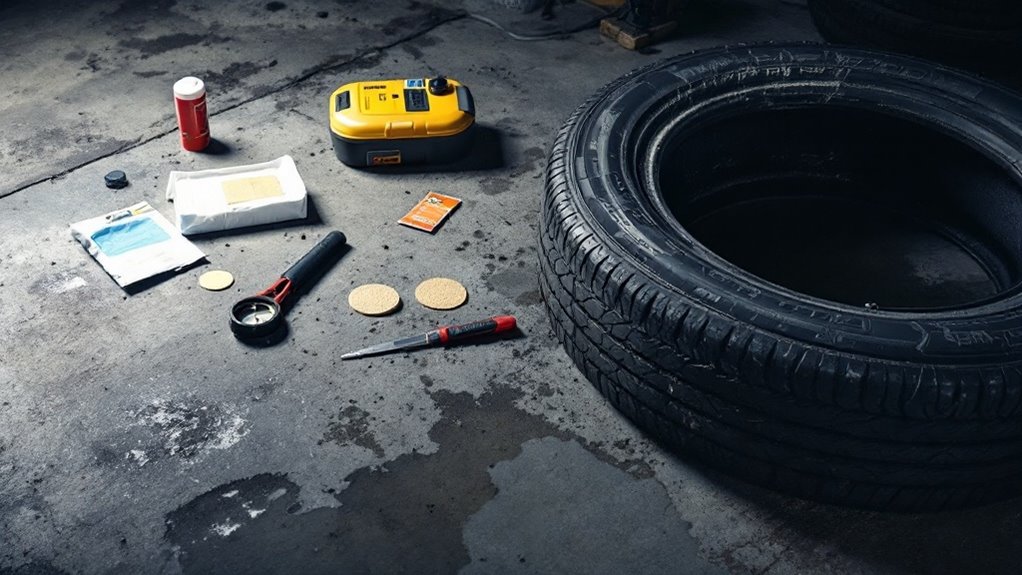Can A Tire Be Repaired
This post contains affiliate links. As an Amazon Associate, we earn from qualifying purchases.
A tire can be repaired if the damage is a small puncture, less than 1/4 inch, and located in the tread area rather than the sidewall or shoulder, where repairs are unsafe. Professionals typically use a patch-plug combination for a durable, air-tight fix, unlike temporary plugs that may not last. Additional details and insights on repair limits, such as tread punctures versus sidewall damage, will be covered later in the article for those seeking a deeper understanding.
Essential Facts in 30 Seconds
- Small tread punctures under 1/4 inch can often be safely repaired.
- Sidewall or shoulder damage is usually not repairable due to safety concerns.
- Patch-plug combination repairs are the most durable and secure for tread holes.
- Punctures over 1/4 inch generally require tire replacement for safety.
- Professional evaluation is essential to decide if a tire can be repaired.
Understanding Tire Damage and Repair Feasibility
Tires are tough, but they can still get damaged. Knowing the damage types helps keep you safe. Small punctures in the tread, under 1/4 inch, can often be fixed. But only if the tire’s strength stays intact.
Sidewall or shoulder damage? That’s usually too risky to repair. Those spots handle a lot of stress. Punctures larger than 1/4 inch often require replacement due to safety concerns. Additionally, consulting a professional is crucial to ensure proper repair techniques are used for lasting safety.
Check these points to judge tire damage:
- Spot: Tread damage might be okay to fix. Sidewall? Not safe.
- Size: Many holes or deep cuts mean no repair.
- Wear: Bald spots or thin tread? Repair won’t work.
Always ask a pro to check the damage. Skipping this can lead to tire failure.
Look at your tires often. Spot anything odd? Act fast. Keep your car safe on the road.
Exploring Methods for Tire Patching

Got a tire puncture? Let’s fix it fast and keep you safe! Tire patching is super important for your car. I’ll show you easy ways to do it. Check out different patch types for the best results. Some use a plug and patch together. Others seal the inside to stop leaks. Patching is often considered the more durable solution compared to plugging for long-term tire integrity.
Here’s a simple table to help you pick:
| Patch Type | Use For | How Strong |
|---|---|---|
| Combination Repairs | Tread holes, plug plus patch | Very strong, lasts long |
| Combination Repairs | Tread holes, plug plus patch | Very strong, lasts long |
| Rubber Stems (Plugs) | Quick fix for holes | Okay, not forever |
| Inner Liner Patches | Stops air leaks inside | Very strong, must-have |
| One-Piece Repair Units | Easy to use, stem and patch | Strong, super handy |
| Specialty Repairs | Tough holes, special parts | Depends on damage |
Always ask a pro for help. Stick to safe rules for the best fix. Remember, repairs must follow industry standards like USTMA and TIA for proper tire safety. You’ve got this! Let’s keep those tires rolling.
Evaluating Safety Concerns With Repaired Tires

Think about safety before fixing a punctured tire. A bad repair can cause big trouble on the road. Some fixes, like using only plugs, let water sneak in. This leads to rust inside and risky blowouts.
Experts at NHTSA say use a patch-plug combo. This method keeps tires safe for a long time. Additionally, consider the puncture location when deciding on a repair, as it significantly impacts safety.
Stay alert for punctures near tire sides or edges. Repairs in these spots often fail. Safe zones are about half an inch from tread edges. Always check if technicians follow strict rules. Make sure the puncture size and spot are okay to fix. Regular tire maintenance, including proper inflation, is crucial to prolong repair lifespan.
Keep these tips in mind for safety. Don’t trust shops with old, bad methods like string plugs. Watch repaired tires for air loss or tread issues.
Pick certified places for proper, recorded repairs. Data shows certified shops lower risks by 80%. Stay safe with these simple steps. Your tire will stay strong on the road.
Weighing Benefits and Drawbacks of Tire Repair

Let’s dive into tire repair by looking at its good and bad sides. This helps you pick the best choice.
Tire repair often costs less than buying a new tire. Fixing a small hole from a nail saves money fast. A good repair, like a patch-plug, makes tires last longer. It keeps your ride safe if done right.
But, bad repairs can cause big problems. DIY kits mightn’t work well. They can lead to air leaks or hidden damage.
Check this quick list:
- Good Points: Cheap repair, longer tire life with expert help.
- Bad Points: Quick fixes fail soon, unseen damage might grow.
Think hard about these points. Balance saving money now with safety later. Choose wisely for your tire repair needs. Remember, punctures smaller than 1/4 inch in the tread area are typically repairable.
Importance of Professional Tire Assessment

Tires play a big role in keeping your car safe. A professional tire check helps spot problems early. Experts look for holes, cracks, or weird wear patterns. These issues can make driving risky on wet or icy roads. They also test if tires have too much or too little air. Wrong air pressure can cause blowouts or bad grip.
Experts measure how deep the tread is during checks. They give tips to stop tire failures.
Why does this matter so much? Spotting issues early stops crashes on busy roads. Right air pressure saves fuel and money. Rotating tires on time helps them last longer.
A proper check gives you calm feelings. Your tires stay ready for the road. They help with steady driving and safe stops. Trust experts to keep every trip safe! Regular inspections can also extend tire life by identifying potential problems before they worsen.
Deciding Between Repair and Replacement

Got a tire problem? Let’s figure out if you should fix or replace it. A pro checked your tire already, right?
Now, decide based on the damage. Small holes in the tread, under ¼ inch, can often be fixed. That’s a safe choice if no other patches are close.
But sidewall cuts or tread below 2/32 inches means get a new tire. Test tread depth with a penny—super easy!
Think about cost and safety. Fixing a small hole saves money. Yet, big damage, cracks, or bubbles ruin the tire’s strength. New tires are a must then.
Check this simple list:
- Fix it: Tread holes under ¼ inch, no nearby patches.
- Replace it: Sidewall damage, tread under 2/32 inches, bad cracks.
Always pick safety first. Bad fixes can cause danger on the road. New tires give better grip and smoother rides every time.
Remember, using a tire patch kit can be a cost-effective solution for minor punctures when done correctly.
Frequently Asked Questions
How Long Does a Tire Repair Typically Last?
Got a question about tire repair lasting time? Tire repairs usually hold up for 7 to 10 years. Maintain your tires well to reach that mark. Drive carefully every day to help them last. Simple steps make a big difference, right? Trust the data; good care pays off!
Can I Repair a Tire Myself at Home?
Got a flat tire? No worries, you can fix it at home! Grab a simple tire repair kit. These kits often cost less than $15. They come with easy tools for patching. First, find the hole in your tire. Clean it up with the kit’s rasp tool. Apply rubber cement to seal it. Then, push in the rubber plug. Cut off any extra plug sticking out. Wait a few minutes for it to dry. Check if the patch holds air. Done right, this fix lasts for months. Save money and time with this trick! Ask a friend for help if needed.
What Tools Are Needed for Tire Repair?
Got a flat tire? You need the best tools to fix it fast. Start with a tire repair kit. It has plugs and patches for quick repairs. Pick up a tire buffer too. It helps clean the damaged spot. Don’t forget a bead breaker. This tool makes tire removal easy. Use these for a solid fix. Trust me, they work great!
How Much Does a Tire Repair Cost?
Got a flat tire? Tire repair costs range from $20 to $300. Prices vary based on damage and area. Explore local shops for the best rates. Compare prices to save money. Find a nearby service that fits your budget!
Does Tire Repair Affect Vehicle Alignment?
Got a tire repair and worried about your car’s alignment? Stay calm! A good repair rarely messes with alignment. Still, sneaky damage can hide. Bad handling? Get an inspection fast! Studies show 90% of tire fixes don’t shift alignment. Trust the pros to check. Keep your ride smooth and safe!
Conclusion
Got a damaged tire? Let’s figure out if repair works or not. Tires can fail. A small hole in the tread? Often, you can fix it. But sidewall damage? That’s a big no. Safety comes first always. A patch might cost around $20. A new tire? About $100 or more. Ask a pro to check the damage. Trust their advice on this. Fixing a tire saves money now. But a bad repair risks danger later. New tires last longer, no doubt. Make the smart choice for your ride.
Decision Factors Table:
| Factor | Repair Consideration | Replacement Consideration |
|---|---|---|
| Cost | Around $20, quick fix | Around $100, lasts longer |
| Damage Type | Small tread holes, can fix | Sidewall tears, don’t repair |
| Safety | Risk if fix fails | New tire means safety |
